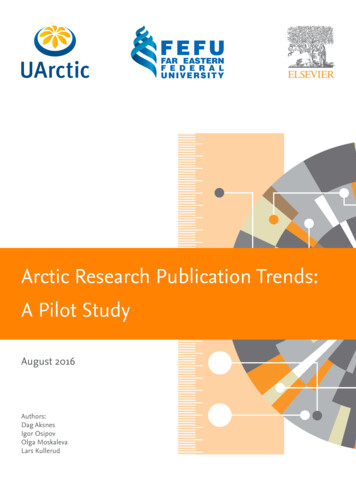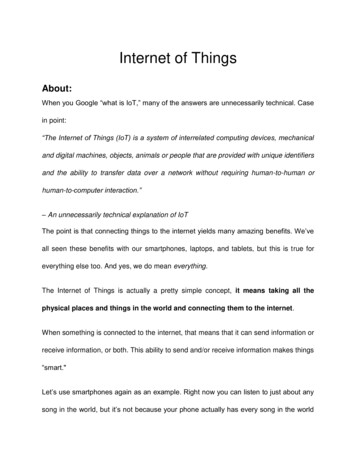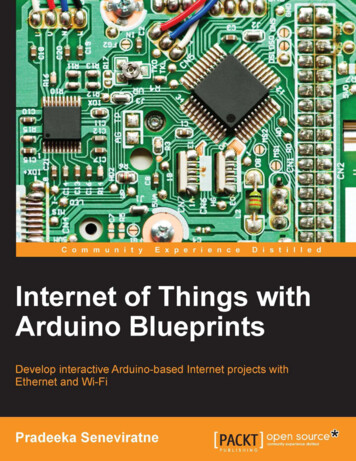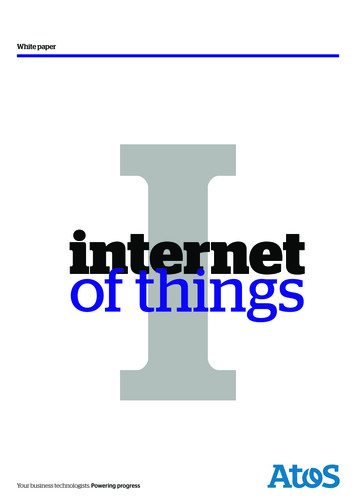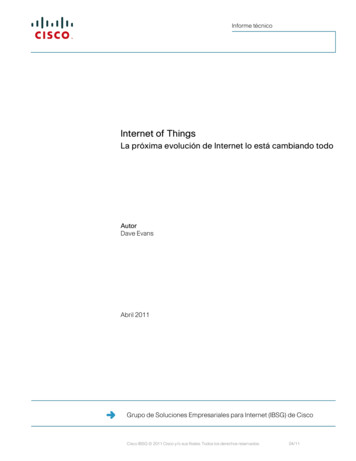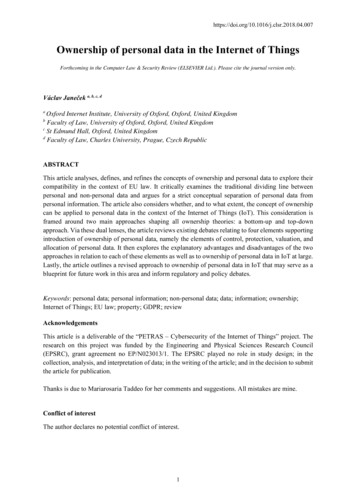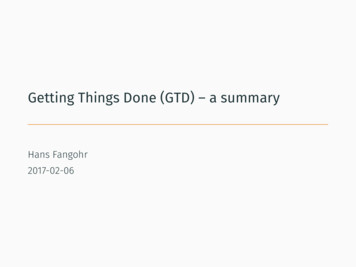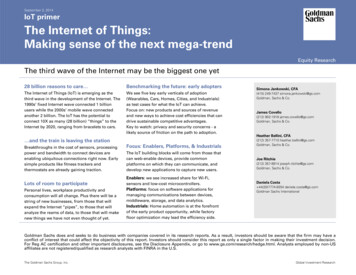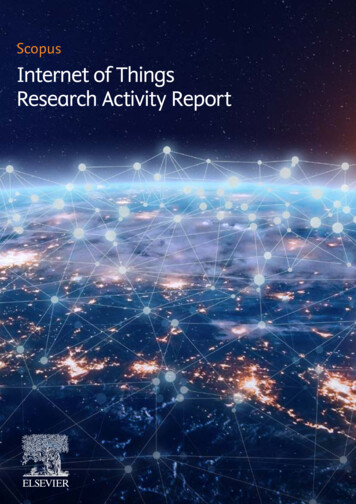
Transcription
ScopusInternet of ThingsResearch Activity Report
Scopus offers researchers an extensive global andinterdisciplinary research database of abstractsand citations from more than 5,000 internationalpublishers, patent records from five major patentoffices and over 8 million conference papers frommore than 100,000 worldwide events.Scopus inspires confident, fact-based innovation decisions, easing the resource and timeconstraints faced by scientists with powerful search, analysis and visualization tools.Researchers can feel confident that they are not missing research findings and trends incommercial application impacting tomorrow’s products.What can Scopus do for you in research areas such asInternet of Things (IoT)?Identify Historicand CurrentResearch TrendsReview WhereResearch IsPresented andPublishedBuild YourFoundationalKnowledge in aResearch AreaIdentify TopUniversities,GovernmentAgencies andIndustrial PartnersPinpoint TopGlobal Authors/ Key OpinionLeadersResearch Methodology and Document Search Parameters forInternet of ThingsThis report is based on analyses performed in Scopus related to a Document Article Title, Abstract, Keywordssearch for “Internet of Things” or “IoT”, rephrased in Boolean as (TITLE-ABS-KEY (“Internet of things”) ORTITLE-ABS-KEY (“IoT”)). The searches for the data presented in this report were run in August 2018.This Scopus Internet of Things (IoT) activity report identifies trends, as well as leading document types,sources, authors and author affiliations, in this research space.Get Attention forYour Work and SeeWho Is Building onYour Research
“The Internet of Things will transformcompanies and countries, opening upa new era of economic growth andcompetitiveness.”3
Historic Trends in “Internet of Things” Research (2008-2017)Documents by 120122013Figure 1: Internet of Things Documents by Year, 2008–2017The phrase “Internet of Things” (IoT) was coined in 19991, but overall searchactivity on the term did not show significant growth until 2010. A current searchon Scopus for IoT using the aforementioned search parameters returns a totalof 32,783 documents when filtered for the past 10 years (2008–2017). Today,Accenture defines IoT as “a universe of intelligent products, processes, andservices that communicate with each other and with people over the Internet.”2Scholarly documents related to IoT remained very low until 2010, at which pointresearch output began to climb dramatically. Related to IoT, in 2010 there were 447documents published, with that number growing to 12,246 documents publishedin 2017.The growth in the number of documents related to IoT during this time periodreflects the swift emergence of IoT as a research focus in academia, industryand government, as well as the steadily increasing importance of the topic in theoverall economy.2014201520162017
The Types of Documents Focused on “Internet of Things” ResearchDocuments by typeOther (0.1%)Chart TitleNote (0.2%)Book (0.3%)Short Survey (0.4%)Editorial (0.7%)Article in Press (1.0%)Review (1.6%)Book Chapter (2.2%)Conference Review (3.6%)Conference Paper (63.5%)Article (26.4%)1234567891011Figure 2: Internet of Things Documents by Source, 2008-2017Conference papers are the largest source for research related to IoT. This accounts forabout 64% of all documents, followed by articles (26%) and all other sources (10%).IoT is a rapidly evolving research topic, which helps explain why research reportsare surfacing faster at conferences than they are being published in peer-reviewedjournals. Moreover, the lead time required for peer-reviewed publications may bedelaying the availability of some key IoT research. A 2017 Hewlett Packard report notesthat edge computing, advanced analytics, machine learning, artificial intelligence,cloud computing, smart homes and smart cities are among the leading IoT focusareas and subtopics.35
Build Your KnowledgeDocuments per year by sourceCompare the document counts for up to 10 sourcesCompare sources and view CiteScore, SJR, and SNIP 4201520162017IEEE Internet Of Things JournalACM International Conference Proceeding SeriesApplied Mechanics And MaterialsLecture Notes Of The Institute For Computer Sciences Social Informatics AndTelecommunications Engineering LnicstLecture Notes In Computer Science Including Subseries Lecture Notes In Artificial IntelligenceAnd Lecture Notes In BioinformaticsFigure 3: Internet of Things Global Top Five Document Sources by Document Count, 2008-2017The importance of conferences in terms of research related to IoT is underscored bythe growth in conference proceedings presented between 2008 and 2017. For example,the total number of papers presented in relation to IoT as part of the ACM InternationalConference Proceeding Series grew from 1 document in 2010 to over 500 documentsin 2017. The Association for Computing Machinery (ACM) is the leading source fordocuments related to IoT since 2011. Other top-ranked source titles during the sametime period include Applied Mechanics and Materials and the IEEE Internet of ThingsJournal.In terms of time-to-market, conference papers are often the best source for learningabout new developments before they are published in peer-reviewed journals. “Thebest technology conferences both teach the tools, processes, and tactics in usetoday, and explore emerging IoT-related technologies,” notes an HP report, whichrecommends leading conferences in the IoT sector. 4
Top Document Sources By Country of OriginDocuments by affiliationCompare the document counts for up to 15 affiliationsBeijing University of Posts and .Chinese Academy of SciencesMinistry of Education ChinaCNRS Centre National de la Re.Tsinghua UniversityElectronics and Telecommunic.Georgia Institute of TechnologyAalto UniversityThe Royal Institute of Technolo.Technische Universitat Wien050100150200250Documents300350400450Figure 4: Internet of Things Global Top Ten Affiliations by Document Count, 2008-2017Document affiliations by country show that China is currently the leading source forIoT-related research documents. The top three affiliations for IoT published research,based on country of origin, are located in China. Leading the affiliations list are BeijingUniversity (413 documents), the Chinese Academy of Sciences (404 documents) and theMinistry of Education of the People’s Republic of China (267 documents).It is important for researchers to have access to documents that represent the mostcurrent thinking and data related to both academic and industry R&D efforts. Resultsfrom the Scopus database underscore the important research work being conducted inmany different countries around the world.7
Top Global Authors: Key Opinion LeadersDocuments by authorCompare the document counts for up to 15 authorsJara, A.J.Skarmeta. A.F.Dustdar, S.Puliafito, A.Atzori, L.Patrono, L.Tenhunen, H.Datta, S.K.Sheng, Q.Z.Zaslavsky, A.010203040DocumentsFigure 5: Internet of Things Global Top Ten Authors by Document Count, 2008-2017The top three authors publishing on the topic of IoT, based on a Scopusdocument by author search, are: Antonio J. Jara, Haute école spécialiséede Suisse occidentale in Switzerland (75 documents); Antonio F. Skarmeta,Universidad de Murcia in Spain (53 documents); and Schahram Dustdar,Technische Universität Wien in Austria (52 documents).50607080
Get Attention for Your Work and See Who Is Building on Your Research1Document titleAuthorsA survey of Internet-of-Things: Future vision, architecture,challenges and servicesSingh, D., Tripathi, G., Jara, A.J.View abstract2Interconnection framework for mHealth and remotemonitoring based on the internet of thingsView abstract5View at PublisherView at PublisherAn architecture based on internet of things to supportmobility and security in medical environmentsView abstractView at PublisherCited by20142014 IEEE World Forum on Internet of Things, WF-IoT20146803174, pp. 287-292137Jara, A.J., Zamore, M.A., Skarmeta, A.F.G2011Personal and Ubiquitous Computing15(4), pp. 431-4401352016IEEE Access4,7406686, pp. 766-7731042013IEEE Journal on Selected Areas in Communications31(9), pp. 47-659620102010 7th IEEE Consumer Communications andNetworking Conference, CCNC 2010542166162Related documentsInternet of Things and Big Data Analytics for Smart andConnected CommunitiesView abstract4View at PublisherSourceRelated documentsAn Internet of things-based personal device for diabetestherapy management in ambient assisted living (AAL)View abstract3View at PublisherYearSun, T., Song, H., Jara, A.J., Bie, R.Related documentsJara, A.J. Zamore-Izquierdo, M.A.,Skarmeta, A.F.Related documentsJara, A.J., Zamora, M.A., Skarmeta, A.F.GRelated documentsFigure 6: Top 5 Documents Authored by Antonio J. Jara on Internet of ThingsResearch by Citation Count, 2008-2017Scopus is an important source of business intelligence andsupport for R&D decision-making. In the healthcare sector,for example, IoT is helping fuel the development of everythingfrom new digital healthcare tools — such as mobile apps — tomore personalized and consumer-centric delivery of healthcaresolutions, including a diabetes treatment protocol evaluated byJara and Skarmeta.In fact, Jara and Skarmeta are two of the leading IoT-relatedauthors, based on the Scopus search results over the pastdecade. They co-authored a 2011 article titled “An Internet ofthings-based personal device for diabetes therapy managementin ambient assisted living (AAL),” published in Personal andUbiquitous Computing. To date, this is the most cited IoT articleindexed in Scopus, having been cited 137 times since publication.The article examines the potential for using IoT to improve themanagement of diabetes in assisted living environments. “Theproposed solution is based on Internet of Things connectivity,”note the authors. The researchers also discuss the developmentof an “Internet of things-based AAL architecture to supportblood glucose management and insulin therapy.”define new advanced systems, to reach a more accuratetreatment of chronic diseases, such as diabetes,” notes thereport. “In addition, Internet of Things allows the defining ofsolutions closer to the patient, physician, and nurses, whichallows an easier integration and acceptance of them.”Looking ahead, the paper views the use of technology in healthcareas an important new development. “Our conclusion is that theInternet of Things is an interesting and promising approachfor personalized health care systems in the next generation ofmHealth (mobile health) solutions,” the authors write.The study, which was at the leading edge of IoT thinking whenpublished, clearly has resonated with other scientists as thetechnology for telemedicine applications has evolved. Theirresearch has influenced other scientists academic, governmentand industrial levels. It also has helped to position the authorsas leading subject matter experts in the use of IoT for healthcareapplications.The evolution of the technology also allows researchers “to9
ConclusionScopus helps authors improve scientific discovery and find the right opportunities forproduct development. By staying ahead of research developments, researchers thatuse Scopus can identify potential institutional collaborators to advance projects andevaluate the research output of competitors. Finally, Scopus is a solution that helpsresearchers contribute to the overall body of knowledge that drives future innovationand growth.The IoT has evolved over the past decade from a largely conceptual idea of connectingpeople and technology to the actual framework for connected computing. It is beingused to help companies across industry sectors process and understand massiveamounts of data in order to make real-time decisions.Today, IoT is driving new growth and product development in healthcare and othersectors. “From smartphones and smart meters to medical devices and sensors,connected devices collect data that creates efficiencies and reduces waste forconsumers and companies alike,” explains an Accenture report.5 “The Internet ofThings will transform companies and countries, opening up a new era of economicgrowth and competitiveness.”References1. Quora (2018). Who Coined the Term “Internet of Things”? Retrieved from www.quora.com2. Accenture (2018). The Internet of Things, The Connection To Growth. Retrieved from www.accenture.com3. Hewlett Packard (2017). 14 Top IoT Conferences To Attend in 2018. Retrieved from www.hpe.com4. Hewlett Packard (2017). 14 Top IoT Conferences To Attend in 2018. Retrieved from www.hpe.com5. Accenture (2018). The Internet of Things, The Connection To Growth. Retrieved from www.accenture.com
Scopus is a solution thathelps researchers contributeto the overall body ofknowledge that drives futureinnovation and growth.11
ScopusScopus enables businesses to identify experts and potential researchpartners, benchmark fundamental research competencies, andgenerate new business opportunities by providing them the world’slargest abstract and citation database of peer-reviewed literature,including tools to track, analyze and visualize research.For more information about Scopus,visit elsevier.com/scopusElsevier officesASIA AND AUSTRALIATel: 65 6349 0222JAPANTel: 81 3 5561 5034KOREA AND TAIWANTel: 82 2 6714 3000EUROPE, MIDDLE EAST AND AFRICATel: 31 20 485 3767NORTH AMERICA, CENTRAL AMERICA AND CANADATel: 1 888 615 4500SOUTH AMERICATel: 55 21 3970 9300Copyright 2018 Elsevier B.V.September 2018
Internet of Things This report is based on analyses performed in Scopus related to a Document Article Title, Abstract, Keywords search for "Internet of Things" or "IoT", rephrased in Boolean as (TITLE-ABS-KEY ("Internet of things") OR TITLE-ABS-KEY ("IoT")). The searches for the data presented in this report were run in August 2018.
